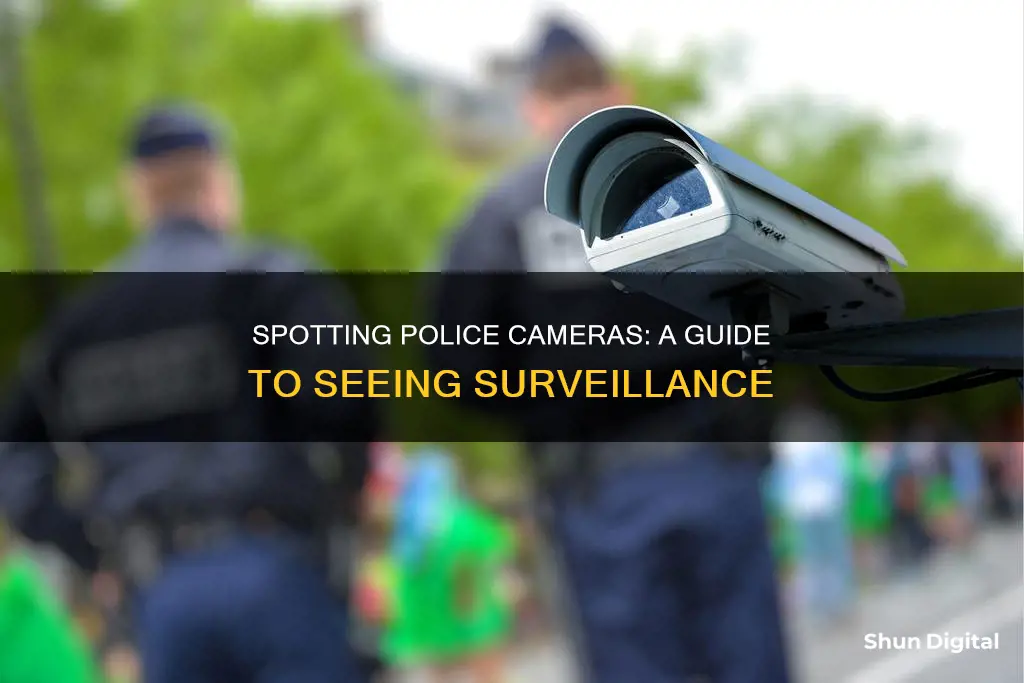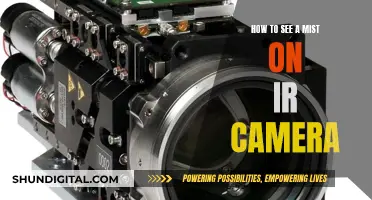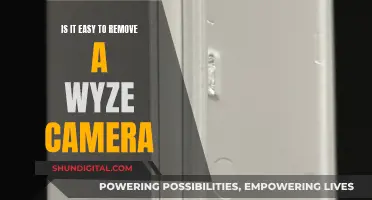
Across the United States, police officers are increasingly being equipped with body-worn cameras to record their daily activities and interactions with the public. The footage from these cameras can be used as evidence in court cases and to increase transparency and trust in police work. While access to police body-camera footage varies depending on state legislation and police department policies, members of the public may be able to view this footage upon request. Interactive maps, such as the one provided by the Reporters Committee for Freedom of the Press, can help individuals understand the specific policies and legislation regarding access to police body-camera footage in their area.
| Characteristics | Values |
|---|---|
| Who can access police body-worn camera footage? | The public may be able to access police body-worn camera footage depending on the state or country. For example, in the US, the public can access footage in some states, whereas in the UK, individuals can only request footage of themselves. |
| How to access the footage | In the US, the public can refer to an interactive map by the Reporters Committee for Freedom of the Press (RCFP) to determine the legislation and policies regarding access to police body-worn camera footage. |
| Cost | In the US, states may charge high fees for processing requests for police body-worn camera footage. For example, in Florida, a request for 84 hours of footage cost $18,000. |
| Redactions | Police departments may redact or withhold footage to protect privacy, confidentiality, and the safety and privacy of individuals. |
| Timeliness | In some cases, police departments may release footage during an ongoing investigation and not wait for its completion. |
| Use of AI | AI is being used to review and analyze police body-worn camera footage to improve police professionalism, supervise individual officers, and rate their performance. |
What You'll Learn

Accessing police body-worn camera footage
The map is colour-coded to indicate the status of legislation regarding access to body-worn camera (BWC) videos. Blue indicates that legislation regarding public accessibility to body-worn camera footage has been proposed but not passed. Yellow denotes that a law has been passed regarding public access. Brown indicates that no laws regarding public access have been passed, although some states have introduced or passed bills regarding BWC implementation. Green signifies that a court case has decided the rules regarding public access.
By clicking on a state, users can find more information and access a link to the relevant bill(s) and/or case(s). Additionally, police department policies can be viewed by clicking on the black camera icons. It is important to note that some police departments that utilise body-worn cameras may not have a formal written policy in place.
In the absence of comprehensive state-wide rules, most police departments establish their own regulations regarding public access to body-worn camera footage. As more states enact uniform policies, individual department policies may be updated to align with the state's standardised guidelines.
In New York, the Office of Special Investigation (OSI) operates under the New York State Attorney General and investigates offences connected to deaths caused by police officers and certain peace officers. To enhance transparency, the OSI releases certain video materials to the public, including body-worn and dashboard camera footage obtained during investigations under its jurisdiction. The OSI aims to provide timely releases, without waiting for the completion of an investigation, while also considering factors such as privacy, compliance with laws, protection of confidential sources, and avoidance of undue trauma.
Additionally, the U.S. Customs and Border Protection (CBP) is piloting a body-worn camera program for officers and agents throughout the United States. The CBP is committed to releasing body-worn camera footage expeditiously, consistent with its policies and Executive Order 14074, which mandates the public posting of body-worn camera policies by federal law enforcement agencies.
Accessing POE Cameras Without an NVR: A Simple Guide
You may want to see also

Public access to police body-worn cameras
Public access to police body-worn camera footage has been a topic of much discussion and legislation in recent years, particularly in light of incidents of police brutality and the subsequent calls for greater transparency and accountability. While some people argue that public access to body-worn camera footage is necessary for holding law enforcement accountable and restoring public trust, others raise concerns about the privacy and protection of ongoing criminal investigations.
In the United States, the legislation regarding public access to police body-worn camera footage varies from state to state. As of 2020, only three states—South Carolina, Nevada, and California—had mandated that all police departments in the state deploy body-worn cameras. A few other states, including Colorado, Connecticut, New Mexico, and New York, have since joined them in mandating the use of body-worn cameras by law enforcement officers. However, it is important to note that the legislation in these states may not explicitly address the question of public access to the footage.
The Reporters Committee for Freedom of the Press maintains a map that provides information on the current state legislation and police department policies regarding public access to police body-worn camera footage in the United States. According to the map, most states have either proposed or passed legislation regarding public access, with a few states having no laws in place. However, the specific policies regarding public access may vary from department to department, as many police departments are left to determine their own rules in the absence of state-wide regulations.
In addition to state legislation, court cases have also played a role in shaping the rules around public access to police body-worn camera footage. For example, in January 2018, a coalition of news organizations successfully obtained access to body-worn camera footage from the Las Vegas Metropolitan Police Department under Nevada's public records law. Similarly, in February 2019, a New York court held that body-worn camera footage was not exempt from disclosure under the state's Freedom of Information Law. These court decisions have affirmed the public's right to inspect police body-worn camera recordings in certain circumstances.
Public access to police body-worn camera footage can be a complex issue, involving a balance between transparency and accountability on the one hand, and privacy and investigative concerns on the other. While there have been calls for greater public access, particularly in the wake of incidents of police misconduct, it is important to consider the potential implications for all involved parties before releasing any footage.
Apple TV: Built-In Camera Privacy Concerns?
You may want to see also

Police body-worn camera footage and release policy
Police body-worn cameras ("bodycams" or "BWCs") have become standard issue for most American police officers interacting with the public. However, accessing the footage from these cameras is not always straightforward for the public.
In the United States, the status of public access to police body-worn camera footage is determined by state legislation and police department policies. The Reporters Committee for Freedom of the Press provides a map detailing the current legislation and policies regarding public access to BWC footage across the country. As of October 2024, only a few states have passed laws regarding public access to BWC footage, leaving most police departments to determine their own rules.
In New York, the Office of Special Investigation (OSI) under the New York State Attorney General has the authority to investigate and prosecute offences in connection with deaths caused by police and certain peace officers. To increase transparency and strengthen public trust, OSI has issued a directive to release certain video materials to the public. OSI will release body-worn camera footage obtained during an investigation over which it has jurisdiction, provided it is permissible by law. The footage may be redacted or withheld to ensure privacy, comply with laws, protect confidential sources and witnesses, protect the right to a fair trial, and avoid undue trauma, among other reasons.
As more states pass regulations regarding public access to BWC footage, individual police department policies may change to comply with state-wide uniform policies.
The Single Camera Show: How It's Different
You may want to see also

AI reviewing police bodycam videos
In the age of police body cameras, artificial intelligence is increasingly being used to monitor officers' body camera footage. After a decade of explosive growth, body cameras are now standard-issue for most American police officers as they interact with the public. However, the vast majority of those millions of hours of video are never watched as it is just not humanly possible. As a result, police departments are turning to AI to review body-cam footage and identify problematic officers and patterns of behaviour.
Benefits of AI Reviewing Bodycam Videos
AI can improve police "professionalism" by monitoring officers' body camera footage, according to the first independent study on the topic. AI systems like TRULEO can assess police officers' behaviour through automated transcriptions of body camera footage. It can evaluate both positive and negative conduct during interactions, such as traffic stops, and provide feedback to officers. In addition to flagging issues like swearing or abusive language, the AI can also recognize instances of professionalism. For example, the system will flag abusive language used by the officer or other people at the scene. This can help supervisors catch the bad habits of officers and reinforce good behaviour.
Concerns About AI Reviewing Bodycam Videos
One concern about AI reviewing bodycam videos is the potential for over-reliance on the technology. Officers may simply cater to the demands of the software, following a formula to accumulate "professionalism points" without a true change of heart. Additionally, the lack of disclosure about the findings of AI reviews makes it difficult to assess their effectiveness in improving police behaviour. While some departments have allowed findings to be publicly released, others have cancelled their contracts with AI providers due to backlash from police unions.
Insignia 4K Smart TV: Built-in Camera or Not?
You may want to see also

Requesting police body-worn video camera footage
In the United States, the status of legislation regarding public access to police body-worn camera footage varies from state to state. While some states have passed laws governing public access to this type of footage, others have yet to do so. As a result, in many cases, police departments are left to determine their own rules regarding the release of body-worn camera footage.
To increase transparency and accountability, some states have implemented laws mandating the release of body-worn camera footage to the public. For example, California requires police departments to release "critical incident" body-worn camera recordings within 45 days of the incident. Similarly, Colorado has enacted a law mandating the release of unedited recordings of police interactions with the public within 21 days of a complaint being filed.
In certain cases, police body-worn camera footage may be withheld or redacted to protect the privacy of individuals, ensure the fairness of legal proceedings, and comply with relevant laws. However, the public release of such footage can play a vital role in holding law enforcement accountable and building trust with the communities they serve.
To request access to police body-worn camera footage, individuals can refer to the current state legislation and police department policies. The Reporters Committee for Freedom of the Press provides a map that allows users to search for the relevant legislation and policies by city, state, or police department. This map is a valuable resource for staying up-to-date with the dynamic landscape of laws and policies surrounding police body-worn camera footage.
Horror Fans Should Watch 13 Cameras: Here's Why
You may want to see also
Frequently asked questions
You can view police body camera footage by checking the local policy regarding public access to police body cameras. The Reporters Committee for Freedom of the Press (RCFP) provides an interactive map that allows you to check the policies and legislation of your state. Keep in mind that accessing the footage may come with challenges and fees.
Yes, the RCFP's interactive map is available online. You can search by city, state, or police department to find the relevant policies and legislation.
Yes, in some cases, you may be able to view police body camera footage in person. You can contact your local police department or relevant organization to inquire about their specific procedures and requirements.
There may be restrictions on accessing police body camera footage, such as high fees, privacy concerns, ongoing investigations, legal proceedings, and consent from individuals in the footage. Additionally, the footage may be redacted or withheld to protect confidential sources, witnesses, and the rights of individuals involved.
The storage period for police body camera footage can vary depending on the organization or department. For example, the Royal Borough of Greenwich stores footage for 30 calendar days, and requests made after 25 days may not be accommodated.







